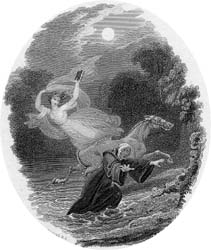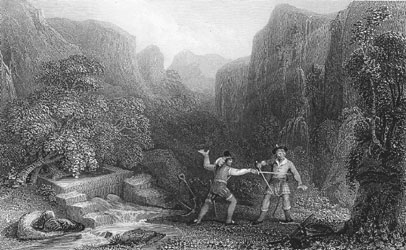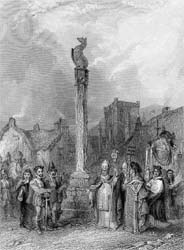|
|
Home | Corson Collection | Biography | Works | Image Collection | Recent Publications | Portraits | Correspondence | Forthcoming Events | Links | E-Texts | Contact The MonasteryFirst Edition, First Impression: The Monastery. A Romance. By the Author of "Waverley". In Three Volumes. Vol. I (II-III). Edinburgh: Printed for Longman, Hurst, Rees, Orme, and Brown, London; And for Archibald Constable and Co. And John Ballantyne, Bookseller to the King, Edinburgh, 1820. Composition | Sources | Synopsis | Reception | Links Composition
Constable accepted the share offered to him in the novel but felt deeply betrayed. He distrusted Longmans and regarded all aspects of the production of The Monastery as suspicious. He was fearful, above all, that sales of The Monastery would harm those of Ivanhoe. Scott, conversely, positively relished the prospect of entering into competition with himself. He initially planned to publish both novels almost simultaneously, without any indication of authorship. He was curious to see whether readers would guess that they were written by the same author. The more cautious Constable, however, finally prevailed upon him to credit both to the 'Author of Waverley'. The novel proper is, however, preceded by an Introductory Epistle by 'Captain Clutterbuck', a military veteran turned antiquarian. Clutterbuck relates how he has come into possession of a Benedictine document relating the history of the fictional Abbey of Kennaquhair and requests the 'Author of Waverley' to edit it for publication. Surviving evidence does not permit the composition of The Monastery to be charted with precision. The title was fixed by 13 August when it was used in a letter to John Ballantyne. It seems likely that Scott began work on The Monastery later in August, having momentarily laid aside Ivanhoe in frustration at the continuing paper shortage. He can only have worked on it for a matter of days, however, before returning to Ivanhoe, and the bulk of the manuscript must have been written after completion of the latter in November. Printing of The Monastery began on or shortly before 29 November, and the final volume was at press by the end of February 1820. Although the novel's main publisher was London-based, The Monastery was first published in Edinburgh on 23 March and not until 30 March in London. SourcesThe Monastery cannot be traced back to any one original source or inspiration. It revisits geographical, historical, and literary material on which Scott had drawn for his Minstrelsy of the Scottish Border and The Lay of the Last Minstrel, and enters into creative dialogue with those works. The story is set in the years preceding the Reformation in Scotland and in the immediate aftermath of the Battle of Pinkie (1547), a catastrophic defeat for the Scots at the hands of Henry VIII's English army. The Border country portrayed in The Monastery is one devastated by Henry's 'Rough Wooing', the name given to his attempts to enforce marriage between the infant Mary Queen of Scots and his own heir, the future Edward VI. It is not, however, a simple matter of Anglo-Scottish rivalry. Scotland is divided between a Catholic faction which favours the 'auld alliance' with France and an emerging Protestant grouping which desires closer links with England. Scott's principle historical sources are William Robertson's The History of Scotland during the Reigns of Queen Mary and of King James VI and John Knox's Historie of the Reformation of the Church of Scotland. For his portrayal of monastic life, he drew on Thomas Dudley Fosbrooke's British Monachism. Other sources include John Lyly's Euphues: The Anatomy of Wit for the courtier Sir Piercie Shafton and La Motte-Fouqué's Undine for the legendary White Lady.
SynopsisThe story revolves around the abbey of Kennaquhair, which Scott based on Melrose Abbey in the Scottish borders. As the Reformation takes hold, the monastic community comes increasingly under threat from the new doctrines. The hero, Halbert Glendinning is the son of a soldier who has died fighting for the monastery. He and his brother Edward are brought up within the grounds of Kennaquhair along with the orphan Mary Avenel, who has been cheated out of her inheritance by her uncle Julian, a ruthless Border baron. Both brothers are in love with Mary, but it is Halbert that wins her favour. An English knight Sir Piercie Shafton flees the court of Queen Elizabeth, having being implicated in a Catholic plot, and takes refuges in the monastery. He sets about wooing the indifferent Mary Avenel, which, along with his arrogant behaviour, angers Halbert. Further antagonism between the two is stirred by the White Lady, a supernatural guardian spirit of the destinies of the House of Avenel, who is opposed to the union of Mary and Halbert. A duel results, and believing he has killed his rival, Halbert flees. He subsequently converts to Protestantism and enters the service of the Earl of Murray, half-brother to Mary Queen of Scots. Shafton, though, is miraculously cured by the White Lady, but his continuing presence at Kennaquhair creates trouble with the English court. He finally surrenders to Murray; his claims to high birth are exposed as false, and he is sent into exile. Halbert has risen so rapidly in Murray's favour that he sanctions his marriage with Mary Avenel (whom the White Lady has caused to be converted to Protestantism). The disappointed Edward Glendinning takes monastic orders and will reappear as the title character in Scott's next novel The Abbot.
ReceptionSales of The Monastery were moderate, though it fared better in Edinburgh than in London. The novel disappointed many, including Scott himself who wrote: 'I agree with the public in thinking the work not very interesting; but it was written with as much care as the others that is with no care at all' (letter to James Ballantyne, 28 March, 1820). Although there were some highly favourable reviews, notably in Blackwood's and the Gentleman's Magazine, critics were almost unanimous in condemning the use of supernatural machinery. The Edinburgh Monthly Review, in an otherwise positive notice, considered the White Lady 'absurd almost to childishness', while the Edinburgh Magazine found her 'insufferable'. Neither did Sir Piercie Shafton find great favour with reviewers and the general reader, seeming to many a gross comic caricature. Such, however, was Scott's selling power after Ivanhoe that commercial success was assured. Links
Last updated: 19-Dec-2011 |
|

 Scott first announced his plans for The Monastery in
a letter to his agent
Scott first announced his plans for The Monastery in
a letter to his agent 
